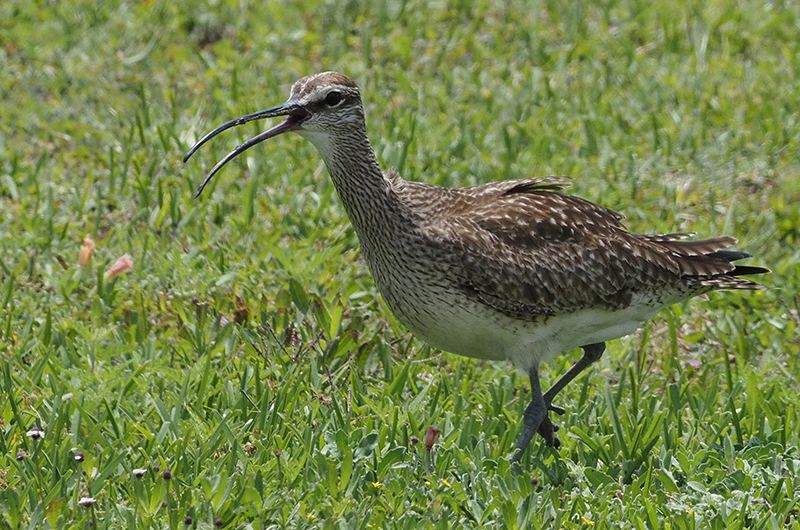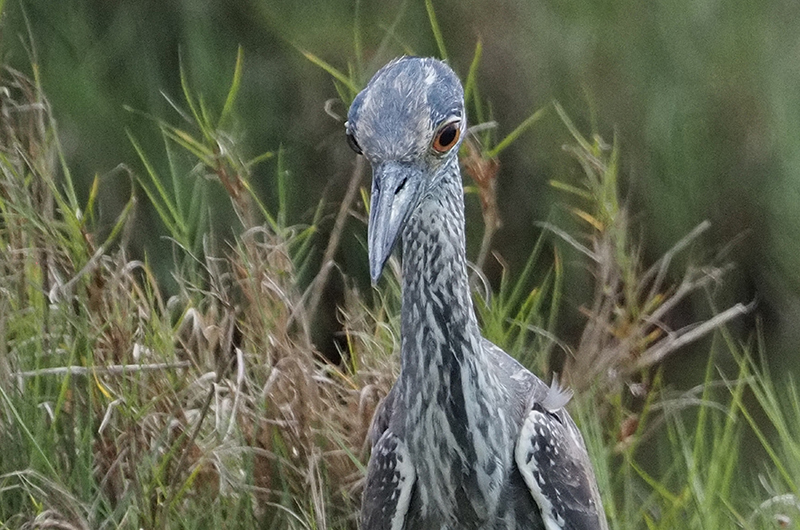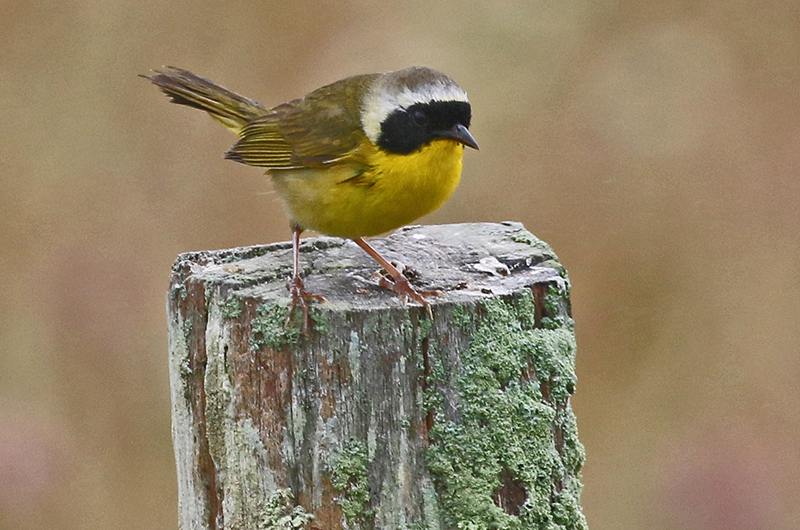In late July adult shorebirds that nested successfully arrive, having left their fledglings alone on the Arctic tundra. Upon arrival here, most start molting their body feathers; sanderlings were quite brown on their heads and backs when they arrived but now are showing a lot of their gray and white winter plumage. Be forewarned: the fledglings that arrive in August have crisp, bright new feathers and so do not look like the adults that are already here, making an already difficult to identify group of birds even more challenging.
Amazingly, the fledglings know when to leave the Arctic and where to go even though there are no adults showing them the way.
Andrew Jankowich spotted the first whimbrel of the season on July 18 at Long Point. And on July 30 Phil Edmundson spotted three of them on the ocean beach between Oyster Pond and Watcha Pond. It is always exciting to spot these large shorebirds with the long down-curved bills.
Another new species for the season is the pectoral sandpiper, first spotted on July 26 by Robert Blumenthal at Katama Point. Two days later both Jeff Peters and Susan Whiting saw one at Black Point Pond. Jeff Bernier visited Little Beach on July 26 and spotted a third new shorebird for the season, a lone red knot.
Kelsey Kovner spotted the fourth new species for the season, a juvenile yellow-crowned night-heron, at Caleb’s Pond. The juveniles are difficult to distinguish from their close cousins the black-crowned night-heron but adults are much easier to distinguish. Steve Allen found one at Felix Neck on July 30, where he also spotted a great blue heron, a green heron, a black-crowned night-heron and two great egrets.
In other shorebird news, the summer resident and southbound shorebird species are still around. They include nesting American oystercatchers, willets and piping plovers as well as migrant killdeer, black-bellied plovers, semipalmated plovers, ruddy turnstones, sanderlings, semipalmated sandpipers, least sandpipers, short-billed dowitchers, greater yellowlegs and lesser yellowlegs.
Various combinations of these species have been reported by multiple observers: David Padulo at Sepiessa Point on July 25 and at Butler’s Mudhole on July 27; on the next day by Jim Shoemaker at Wasque, Andrew Jankowich at Long Point, and by Susan Whiting, Bob Shriber and Jeff Peters at Black Point Pond; the participants of the July 30 Martha’s Vineyard Bird Club’s Birding 101 field trip to Quansoo Farm; Luanne Johnson on July 31 at Sarson’s Island and Farm Pond; and by Clifton Stone at Lighthouse Beach in Edgartown and Tom and Dottie Block at State Beach on July 31.
Of course this season is not just about migration; it is still the nesting season and recent fledglings — youngsters that have left the nest — are widespread and fairly easy to spot. A quick reminder that a young bird that appears to be by itself really isn’t; an adult is nearby and will tend their youngsters although they may not feed it every time it begs for food. Their interactions are fascinating and can be watched from a distance.
Ospreys are fledging now and Rob Bierregaard is here to record their productivity. He reports that the average number of fledglings is 1.7 per nest, which would be the second highest year of the past 25. Reports of fledged or fledging birds from an osprey nest near you will help with this compilation.
He has also observed three northern harriers, including one fledgling, on July 26 at Round Pond, recently-fledged grackles along Shawanue avenue in Oak Bluffs on July 29, and a family of four eastern kingbirds on July 27 at Cove Meadow Preserve.
In other hawk news, Karen Swift-Shannon reports two juvenile red-tailed hawks using unusual perches — her gutters and deck railing — on July 26. Sue Mead has also observed a young red-tail. Shea Fee watched a family of house wrens feeding their fledglings at Wasque on July 26. I observed a family of three green herons at Butler’s Mudhole on July 28. Pete Gilmore saw a flock of 18 bluebirds, including multiple youngsters, as they foraged in the grass on July 29 at Nat’s Farm. And Margarita Kelly observed two fledgling cardinals.
There have been five sightings of bobwhites this week. On July 26 Bridget Dunnigan and Sea Williams spotted them along Beth’s Way in Edgartown, Mickail Simmons found them near Nashaquitsa Pond, and Shea Fee saw them at Wasque. On July 28 Jim Shoemaker also reported the Wasque birds, and on July 31 Dave Higham observed a covey of 10-12 birds on Pin Oak Circle in West Tisbury.
A Martha’s Vineyard Bird Club group walk on July 26 at Great Rock Bight, led by Bob Shriber and Soo Whiting, produced highlights including eastern wood peewee, red-eyed vireo, hairy woodpecker and a very vocal but skulky black and white warbler.
Other warbler sightings include Steve Allen’s common yellowthroat and pine warbler at Felix Neck on July 30, and a common yellowthroat observed by Luanne Johnson near the Bend in the Road Beach on July 31 (and three saltmarsh sparrows). Warblers appear to be fairly scarce now.
Other miscellaneous sightings are Pete Gilmore’s brown thrasher along Lobsterville Road on July 28, and on July 27 he spotted a phoebe and two kingbirds. Susan Whiting saw a single, female orchard oriole and five Baltimore orioles along Old Fields Path on July 28. Clifton Stone spotted eastern wood pewee, great crested flycatcher and four red-eyed vireos at Great Rock Bight on July 27. And my apologies to the observer who sent a photo of an indigo bunting that I misplaced and so I do not have your name.
Finally, I spotted a Virginia rail at Butler’s Mudhole on July 28. Al Sgroi watched a fish crow at Trinity Park on July 30 and the next day I heard several calling near downtown Oak Bluffs.
Please email your sightings to birds@mvgazette.com
Robert Culbert is an ecological consultant with Nature Watch LLC living in Vineyard Haven.











Comments
Comment policy »